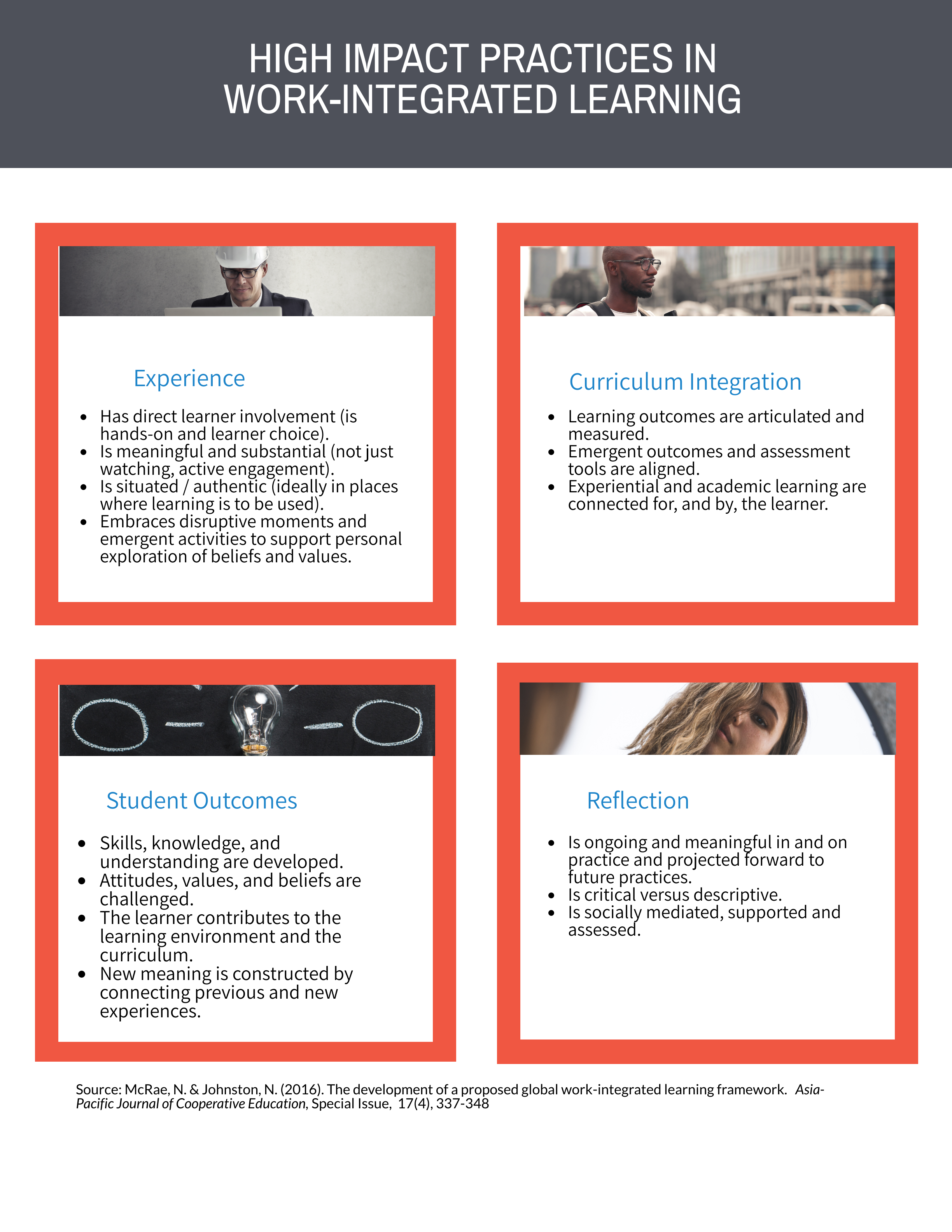Quality in WIL
The concept of quality in higher education means different things to different people (Harvey & Green, 1993). While intuitive definitions of quality are commonplace, quality has been referred to in research as a slippery concept latent with philosophical and political understandings (Harvey & Green, 1993). Some positions on quality are underscored by outcomes, some by process.

In Canada, CEWIL provides an accreditation service based on a set of quality standards for co-operative education programs across the country. This accreditation service plays an important role in the evolution of quality co-operative education in Canada. Not only does it establish a national definition of co-op, it also provides institutions with a set of quality attributes to aspire to even if they were not interested in becoming accredited (McRae, Pretti, & Church, 2018). This has assisted the consistent development of co-operative education across the country and created a national quality standard for all Canadian co-op programs.
Currently, there does not exist a quality accreditation service for all types of WIL. Yet, quality in WIL has been a long-standing consideration and there is a Canadian National Quality Improvement Council working on quality assurance indicators and review processes for the other (non-co-op) work-integrated learning types.
WIL Quality Frameworks
There are a variety of factors that receive attention when considering quality in WIL. These have been cited as including the WIL types’ value for achieving its purpose and outcomes and “the quality of the learning experience, supervision, preparation and debriefing experiences…although exactly what is meant by ‘quality’ is likely to differ across stakeholders as well as disciplines” (Hay, 2020).
Many scholars have advanced and supported how quality and safe learning experiences are understood in WIL. A brief overview of notable contributions to WIL Quality are shown in the presentation below.
Quality in WIL flipbook transcript.docx
WIL Quality Attributes
As noted above there are several important attributes that should be at the core of a quality WIL program. The Accreditation and Quality Councils of CEWIL have articulated many of these and they also constitute the core of several quality frameworks and models such as the PEAR, the WIL Matrix, and the AAA Framework to name a few. While some programs in Canada, such as co-operative education, have clearly articulated accreditation criteria, other WIL programs may vary more in their design and delivery. However, there are several curricular elements that form the core of all quality WIL program types.
This core of attributes is based upon years of research and best practice that have informed how students learn best through experiential education. These understandings have enabled WIL program designers to better ensure optimal learning results from such models of education. The infographic below pulls together the high-impact practices in work-integrated learning.

HIGH IMPACT PRACTICES transcript.docx
 |
To learn more: 2. Review resource if you are interested in a Quality Framework for Work-Integrated Learning Preparatory Curriculum. This framework aims to support British Columbia (BC)/ Yukon post-secondary institutions in the development, implementation, and evaluation of work-integrated learning (WIL) educational programs designed to prepare students prior to entering their workplace or practice setting (Sator, Sator, & Johnston, 2021). 3. Consult the Global Co-operative and Work-Integrated Education Charter for some further ideas. |
Quality and Inclusion
To be recognized as a quality program means that time has been taken to evaluate the ways all students are recruited to, retained in, and graduated from WIL programs. Other critical elements that make for quality learning experiences includes making sure there are multiple means of engagement, multiple means of representation and multiple means of action and expression so that the diversity of students' knowledge can be fully expressed and appreciated. These are principles from Universal Design for Learning. See more at CAST UDL Guidelines.
Historically there has not been a lot of work done specific to exploring the concepts of diversity and inclusion in WIL. Some studies are available (see IJWIL) investigating barriers to access and success for students with disabilities, from Indigenous backgrounds, and from international pathways, but more resources are required regarding how to assess and ensure inclusion in your WIL offerings. For this reason we dedicate the entire next section to this topic.
Reflective Prompts
|
|
Think about your WIL program(s) and take a moment to unpack your offerings and understand the quality attributes that are present and/or absent. Do you see some evidence of the quality attributes noted? Do you see opportunities for growth and possible program renewal? Is there one thing you could do right away that would make a positive difference? |